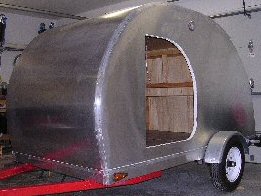What no one seems to be answering is the part of your question about it being an "already built TD", not a new build in progress.
Just some random thoughts on the subject that you may wish to consider:
Did you build it, or do you know who did; and if so, is there an accurate record of where the roof spars are located, what size they are and how deep/thick? If it is a manufactured camper maybe the maker could advise you.
Can you tell where they are by looking at the inner/ceiling skin? (Do you have an inner ceiling skin?) Staples, trim, use a magnetic stud finder to find any fasteners?
So you are going to need to figure out:
1) Where your existing roof spars are, and determine how much space you have between them.

2) Where the wiring is if any of it runs in the roof.

It is very common for the wires to run thru the roof.
3) The curvature of your roof.
4) ...probably something else that I have not thought of.
If you are 100/ct guaranteed that you are going to commit, you could decide on the location and size that you want and do a little exploring. By drilling a small exploratory hole in your ceiling panel in the field of where you want the moon roof to go, and then probing thru the hole with a piece of wire, you will be able to get a pretty good idea of how much space there is, where the adjacent spars are located, and if there are any wires in the way.
If it looks problematic from here, it would not be too much trouble to patch up the small hole and call it off.
If the spars are closer together than the front to back width of the window you intend to use, then you will likely have to header off at least one spar.
If the curvature of your roof is severe and you plan to use a preframed factory made window, you may have to make your rough opening larger so that you can build out the headers and spars to create a raised flat frame for the window (kind of like a skylight on a house, or Sharon's Myaway pop top tiny camper that has a raised lip all the way around the top opening. (Not sure that this will be aesthetically pleasing to your profile.) Options include using a piece of plexiglass or Lexan. Thinner sections have quite a bit of flex and can conform to a radius, or thicker pieces can be heated to allow forming (be careful tho, forming can tend to ruin the already not great optical quality).
I can tell you one thing, the more I think about it, the more I think that it is a bad idea, at least not if you don't know the answers to these questions. New construction? Sure, go for it. Easy enough to design in the features needed, but in a rework situation, kind of a lot of unknowns conspiring against you.
It's certainly doable, but you will want to know what you are getting into before you take the plunge.








